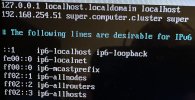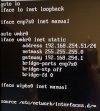I recently installed Proxmox v.8.2-1, booted and installed it on my computer without error, but I have been unable to ping the IP address of the server or connect to the provided GUI link. I added a static IP address with the IP address of the below proxmox server with the MAC address that was displayed next to it but when I ping the static address the destination host is unreachable. When I attempt to search the given GUI link it gives me a took to long to respond error.
SERVER IP : 192.168.254.122
DHCP starts at 192.168.254.1 goes to 192.168.254.254
/etc/network/interface is attached
SERVER IP : 192.168.254.122
DHCP starts at 192.168.254.1 goes to 192.168.254.254
/etc/network/interface is attached




